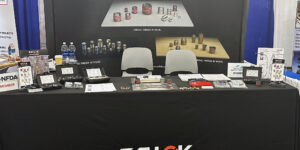THE EYES HAVE IT
Seeing is Believing: Effective labeling goes a long way toward enhancing reliable asset performance.
Posted: December 10, 2008
Manufacturers committed to lean initiatives know how critically important it is to stabilize and optimize equipment performance. Lean practices not only deliver significant advantages, they also identify specific needs to improve equipment reliability. The most common example of this is found when lean operations reduce inventory found in the buffer stock that previously existed to fall back on in the event of a breakdown. Removing this waste places more demand than ever before on the equipment to function properly.
Reliable production processes and equipment have become key competitive advantages to be leveraged and sustained over the long term. For this reason, the focus of maintenance is shifting from fixing breakdowns to maximizing overall equipment effectiveness (OEE). Reliability-focused maintenance practices are now the cornerstone of world-class manufacturing programs.
VISUAL SYSTEMS = PROACTIVE MAINTENANCE
While visual devices are already widely used in 5S, standard work, quick changeover, kanban and other lean techniques, they should also be considered as an important component of any proactive maintenance strategy. Incorporating visual devices into your reliability program can provide many benefits:
? Simplified training.
? Improved quality, fewer errors and defects.
? Ability for virtually anyone to detect abnormalities at a glance.
? Faster troubleshooting and repairs.
? Fewer unplanned maintenance, repair and operation (MRO) purchases.
? Reduced inventory.
? Improved safety and employee morale.
A good starting point is to use signs and labels to identify preventive maintenance (PM) points and to provide basic cleaning, inspection and lubrication instructions. Using visual devices to identify PM points and provide detailed instructions is especially important if your company implements an autonomous maintenance program where the responsibilities for routine care and inspection are transferred to equipment operators instead of trained maintenance professionals. Clearly defining their tasks and checkpoints becomes absolutely critical.
AND THEN . . . BOOM!
The growing number of inexperienced technicians in the workforce increases the risk of errors and omissions. As 78 million baby boomers retire in the next 10 to 15 years, the shortage of skilled workers will significantly affect industry. For example, one large well-known manufacturer says 70 percent of its maintenance staff will have less than five years of relevant job experience by 2014.
For example, improper lubrication ? too little or too much ? is a major cause of equipment failure. A simple lube label can save your company significant costs in motor repair and replacement. Color-coded markings can also be applied to zerk fittings and grease guns to guard against using the wrong type of lubrication (see Figure 1).
Oil level indicators can be applied to sight tubes to simplify oil management. The use of green and red striped labels placed behind the sight tube lets the operator easily detect when oil levels are too high or too low.
REDUCING RISKS
Even when maintenance personnel retain control of these activities rather than the equipment operators, the growing number of new and relatively inexperienced technicians in the workforce is increasing the risk of errors and omissions. As baby boomers retire ? about 78 million in the next 10 to 15 years ? the coming shortage of skilled workers will continue to significantly affect industry. One large well-known manufacturer recently forecasted that by 2014 approximately 70 percent of its maintenance staff will have less than five years of relevant job experience.
Maintenance workers must also learn how to use a growing number of sophisticated predictive maintenance technologies, such as vibration analysis, ultrasound and thermal imaging. When performing predictive maintenance tasks, it is critical to take measurements in the same exact place every time. To ensure the location for readings remains consistent ? regardless of the technician conducting the inspection ? predictive maintenance targets can be applied.
When implementing predictive maintenance programs, reliability technicians often use inspection routes to streamline the process and maximize efficiency. One drawback to this approach, however, is that the technician may not be familiar with each and every piece of equipment, and the proper readouts may vary across different machines. Visual controls like a gauge label help to alleviate this obstacle by making it clear to anyone at a glance whether the temperature or pressure is within the normal operating range. In fact, these visuals make it so easy to detect abnormalities, that anyone walking by becomes a potential inspector, facilitating early detection of potential problems.
Visuals not only make it easy to detect when chain tension is too loose, but they also advise when to replace the chain (see Figure 2). When tension slackens, links from the chain should be removed, and the adjustment block can be shifted to restore proper tension with the shorter chain. Once a specified number of links have been removed, the edge of the block extends outside of the green area, clearly indicating that the chain should be replaced.
TROUBLESHOOTING AND REPAIR
Visuals can also speed troubleshooting and repairs. For example, including "to" and "from" information on equipment ID labels makes it easier to trace lines in electrical systems and pipe networks. As a result, you can perform repairs faster and reduce the risk of errors and potential injury (see Figure 3).
GOT SOME ID?
Though the maintenance storeroom is the biggest contributor to maintenance inefficiencies, it offers plenty of opportunities for improvement through visual controls that ensure the proper replacement part and its storage location are clearly identified.
Maintenance stores are perhaps the biggest contributor to maintenance inefficiencies. Your storeroom may offer plenty of opportunities for improvement through visual management. You can make repairs even more efficient by ensuring that the proper replacement part and its storage location are clearly identified, ideally by putting the information right at the point of need as shown above (see Figure 4).
To reduce search time and ultimately reduce downtime, clearly label shelves and bins in stock rooms and tool cribs. Where possible, use graphics and/or photos on your labels for faster recognition and to avoid pulling the wrong part. To enhance safety and reduce hazards, many companies now post graphical lockout procedures, including instructive photos, right on or at their equipment. Posting hazard warnings and safe work instructions right at the point of need is the most effective way to reduce accidents and injuries at your plant, and is as important (if not more so) than classroom or computer-based safety training.
When restoring equipment to operation, how can you ensure efficient and error-free setup? Visuals such as the operator control panel labels and alignment aids shown above help to simplify machine settings and positioning (see Figure 5).
Labeling the rotational direction on gears and shafts can also help you avoid costly setup errors that can damage or destroy motors and drive systems.
CREATE YOUR OWN VISUALS
You can increase efficiencies and reduce costs by investing in an industrial printer and a flexible, easy-to-use software program. Programs on the market now have templates that allow you to easily produce labels and signs similar to the ones we have discussed. You can create your own industrial-grade visuals on-site and on-demand at a fraction of the cost of having them printed by an outside vendor.
When investigating ways to improve equipment performance and reliability, it pays to keep your eyes open for new ways in which visual systems can benefit your overall lean initiatives.
Chris Rutter is the senior marketing manager for Brady Worldwide, Inc., P.O. Box 2131, Milwaukee, WI 53201-2131, 888-250-3089, www.bradyid.com/visualworkplace.









